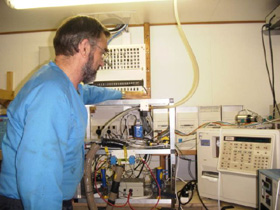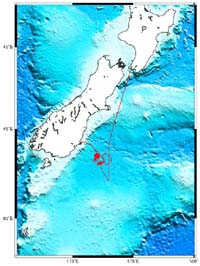Cruise
Log: Friday, April 2, 2004
|
March
|
|
Sun
|
Mon
|
Tue
|
Wed
|
Thu
|
Fri
|
Sat
|
|
|
1
|
2
|
3
|
4
|
5
|
6
|
|
7
|
8
|
9
|
10
|
11
|
12
|
13
|
|
14
|
15
|
16
|
17
|
18
|
19
|
|
|
|
|
|
|
|
|
|
|
|
|
|
|
|
|
|
|
April
|
|
|
|
|
|
|
2
|
|
|
|
|
|
|
|
|
|
|
|
|
|
|
|
16
|
17
|
|
18
|
19
|
20
|
21
|
22
|
23
|
24
|
|
25
|
26
|
27
|
28
|
29
|
30
|
|
|
| |
 |
|
Associate
Professor Graham Jones with the automatic underway dissolved DMS analyzer
used onboard Tangaroa. |
 |
Location
of the R/V Tangaroa on April 2, 2004.
Position: 46 34. 12S 172 01. 12E |
Contributor: Graham
Jones
Southern Cross University, Australia
Dissolved dimethylsulphide (DMS) is determined onboard by Associate Professor
Graham Jones (Southern Cross University, Australia), Mike Harvey and John
McGregor (NIWA), and Hilton Swan (Australian Government Analytical Laboratories,
Sydney). A measurement is made every 14 minutes and this data with sea surface
temperature and wind speed measurements will be used to calculate the flux
of DMS as Tangaroa samples in and out of the patch. Wind speed has varied
markedly during this voyage and seems to have affected not only the biological
response and supply of DMS to the surface ocean, but has also stripped the
surface ocean of DMS. Comparison of DMS flux measurements using the equations
derived by Liss and Merlivat with flux measurements using the relaxed eddy
accumulation (REA) technique developed at NIWA by Mike Harvey and Murray
Smith will also be made on this voyage. In
addition, CTD samples of "in patch" and "out of patch"
seawater have been processed for phytoplankton pigment measurements by Dr.
Simon Wright of the Australian Antarctic Division. Next
Day >>
|